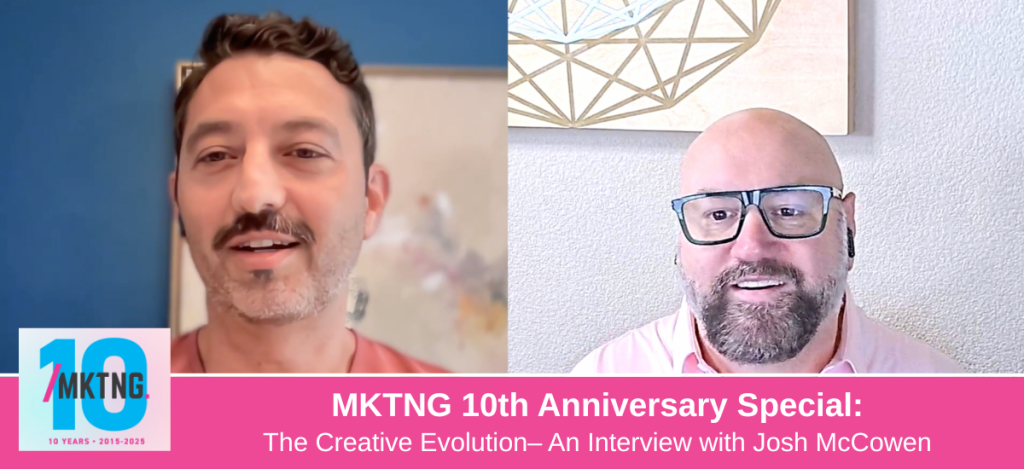MKTNG 10th Anniversary Special: The Creative Evolution – An Interview with Josh McCowen

Host Scott Eggert and Creative Director Josh McCowen discuss the evolving creative landscape over the last decade, noting the massive shift from print design to digital platforms like social media and websites. While embracing the speed of modern tools like Figma and Photoshop, Josh stresses the continued importance of fundamental creative strategy and manual processes, such as sketching on paper, to generate recall and meaningful ideas. The conversation zeroes in on the opportunities and challenges posed by the modern social environment, using the Cracker Barrel rebrand as an example of how public opinion can impact even established brands. They dive deep into the pervasive influence of AI (like Midjourney), which Josh uses as a technical and coding partner, but caution that current AI tends to produce “remarkably average” content and lacks the essential strategic perspective needed for truly great branding. Finally, Josh shares his work on his new venture, A Remembered Life, and wraps up the discussion with a quick “Keep or Kill” lightning round, where he keeps most design concepts but kills Papyrus and direct mail. Key Topics: The Evolution of Design and Marketing The Importance of Manual Creative Process The Impact of Social Media on Branding Defining a Brand AI’s Role in Creative Workflow Limitations and Caveats of AI The Future of Technology in Business Entrepreneurship and New Ventures “Keep or Kill” Design Concepts Personal Creative Pursuits Transcript: Scott: All right. So what does it take to build a brand that lasts? We’re exploring that very question today on the MK ten podcast. I’m the host, Scott Agar, president of MK tag. And I couldn’t think of a better person to discuss this with. And uh, our, my friend and our creative director, Josh McCown, uh, who’s been, uh, fostering, uh, innovation and working with collaborative, uh, teams from doing global brand launches and innovative digital experiences, his work has consistently pushed the boundaries. I can’t wait to dive into the story of creative evolution with him. Josh, it’s great to have you here. Welcome to Mk2 G10. This is a series you put together just to celebrate our ten years, and Josh is a cool part of that story. Cool. Glad to be here. Yeah. Yeah. So, uh, since we’re, you know, ten years, uh, for our outfit here, we, like, we’ve been kind of talking to, uh, you know, everybody on our team, uh, and some previous team members, kind of about what has changed in your tenure, uh, as a designer, what’s something that, uh, you know, you used to do that would just seem archaic, uh, if you were to, you know, pick up that tool or technology and use it today. Josh: I mean, I think the biggest thing for me is, as broadly as it sounds, print, um, which I desperately miss. Um, certainly there’s large brands that still do a lot of print work and, you know, you still see print, but, you know, working with modern tech startups today, a lot of companies, they’re all digital. It’s social media, it’s a website, it’s email. And that’s as far as they take their brand and marketing touchpoints. Obviously brick and mortar shops, things like that, restaurants, you know, anything where there’s a human in person, there’s still going to be some type of collateral. But yeah, I, I wish, I wish more brands to still did print design. Um, that was my initial, uh, endeavor into the design world was illustration and building brochures and annual reports and things like that. Um, but today we we pretty much just do websites and social media and applications and, you know, much more of a digital world these days. Scott: Yeah. Like is there. Are there any tools or a process that you do now that’s just like 180 degrees from how you used to do things? Josh: Um, I’m sure there is. I’m trying to think if there is something that we did like so manually that I got replaced. I mean, obviously we’ll touch on it as the conversation goes on, but AI is changing some of our kind of baseline processes. But I think from a kind of fundamental creative process understanding, uh, discovery process, a lot of the things that we do, or at least I do, I try to kind of maintain some of those best practices from, from before because they weren’t, you know, the tools can help us move faster, but they’re not going to answer our questions. They’re not going to know our insight. They’re not going to be able to pull out some of the things that, you know, you and I and some other, uh, industry people that have been in the around as long as we have the knowledge that we have. So, you know, I maybe don’t sketch as much as I used to on paper, um, when I’m working on maybe collateral or logos and things like that. But, you know, we still use Photoshop. Maybe not as much as we used to in the past. Um, but yeah, I, I can’t think of anything, like, so obvious. And maybe that’s the problem. Maybe there’s something that just it just disappeared, you know, over time. So inherently. But yeah, I, I still love a lot of the manual touchpoints of, of the work. You know, I think that’s one of the things that I enjoy doing the most is the actual creative work, not just the management of it or the direction of it, but actually getting my hands dirty. Um, so yeah, I think. I think my process is maybe the same for the most part. You know, maybe sped up with technology. Scott: Yeah. You mentioned, uh, sketching, which is interesting. Um, probably ten years ago. Right? Like we all thought, oh, we’re all going to start doing that on tablets. Like, did that ever work for you? Did you ever use a digital thing
Beyond AI Hype: Finding Practical Communications Value in a Sea of Possibilities

In the midst of AI’s meteoric rise, there’s a conversation not happening nearly enough outside tech conferences and industry echo chambers. While Silicon Valley debates the philosophical implications of frontier models, most professionals are asking much more practical questions: “How does this actually help me serve my clients better?” and “Is this worth my limited time and resources?” and “What are the ethical considerations?” and “Which tool is best for me and worth paying for?” As a small business owner and consultant, I’ve felt this tension firsthand. Between client deliverables, invoicing, business development, and the countless other responsibilities of running a consultancy, finding time to navigate the overwhelming landscape of AI tools feels like yet another unpaid task on an already overflowing plate. The Implementation Gap The disconnect between AI’s theoretical potential and practical implementation remains substantial because the technology itself only gets you so far. The real challenge lies in meaningful adoption that delivers tangible value. (Not to mention another fundamental question: Is it possible to achieve this without wiping out jobs, careers, and entire industries? By using AI, am I simply training my replacement?) This challenge is particularly acute for communications and marketing professionals. We trade in human connection, authentic storytelling, and strategic thinking—precisely the areas where AI’s application requires the most nuance and oversight. For that reason, I think the most creative ideators will ultimately survive the robot invasion. Only time will tell. The Tool Explosion Problem The proliferation of specialized AI tools has also created the latest version of decision fatigue. Need to convert text to speech? Here are a thousand options, each requiring research, trial periods, and subscription commitments. As you develop proficiency with one platform, a new competitor emerges with different capabilities and limitations. Just when I thought I had mastered ChatGPT and Claude AI, here came DeepSeek with Magnus hot on its heels. (Claude AI is still my favorite for content creation.) This constant churn generates significant opportunity costs. Time spent evaluating and learning new tools is time not spent on client work or business development. This represents a genuine business challenge for independent professionals rather than just an adoption hurdle. Practical Pathways Forward For communications and marketing professionals looking to navigate this landscape thoughtfully, here are a few of my favorite ways to balance innovation with practicality: Start with pain points, not possibilities: Rather than exploring what AI can do in theory, identify your most time-consuming or creatively draining tasks. The best implementation often addresses existing frustrations rather than creating new workflows. Embrace the “second draft” approach: Let AI generate rough initial content that you significantly revise and elevate. This preserves your voice while eliminating the intimidation of the blank page for routine work. Build a focused toolkit: Rather than chasing every new release, select 2-3 versatile platforms that address your core needs. For many professionals, this might include a text generation tool, a multimedia creator, and a research assistant. Futurepedia is a great resource for exploring and determining the best tools and software to suit your needs. Create guardrails through prompting: Develop and refine standardized prompts that consistently produce useful starting points for your work. Well-crafted prompts incorporating your brand voice and strategic preferences become valuable intellectual property. Claude AI enables you to build “projects” that capture brand voice, messaging, tone, and format, giving you more time for strategy and content ideation, editing, and refinement. Use AI for expansion, not contraction: Apply AI tools to explore more angles, create more variations, or develop more comprehensive supporting materials rather than simply automating what you already do well. Treat AI as a collaborative partner: Frame your relationship with these tools as collaborative rather than transactional. The most valuable outputs often emerge from multiple rounds of human-AI iteration rather than single-prompt solutions. The real opportunity isn’t replacing our expertise with automation but extending our communications capabilities into areas previously constrained by time and resources. When approached thoughtfully, AI tools can amplify our distinctly human talents rather than substitute for them.
Navigating the Ethical Landscape of AI in Communications and Marketing

As communications and marketing professionals, we’ve watched with fascination as artificial intelligence (AI) has transformed our industry. From chatbots to content generation tools, AI is undeniably powerful in helping streamline processes, boost productivity, enhance creativity, and improve audience engagement. The marketplace has been proliferated with tools and apps promising MAGICAL results (the symbol most companies are using to denote AI is magic sparkles ✨). However, in many respects, the use of AI is more like a Magic 8 Ball than what you see in demos. The good news is that humans are still very much needed, at least for now. And as we’ve experimented with these technologies, we’ve also grappled with the complex ethical questions and challenges they raise for communicators and marketers. It has become clear that technology vendors are less concerned with ethics as they iterate and expand the features of their products. One glaring example is Open AI’s new voice assistant sounding eerily similar to actress Scarlett Johannson even after she declined their offer. Indeed, much of the reference materials fed into the large language models (LLMs) that AI platforms are built on were done so without the permission of the content owners/creators. While those instances are not the primary subject of this post, they leave those of us who use these platforms with a sense of caveat emptor when using them. With all that in mind, here are the several concerns organizations should keep in mind while considering the ethical use of AI: BIAS & INACCURACIES: AI algorithms are only as good as the data they are trained on, and they can perpetuate biases and inaccuracies if not carefully designed and monitored. AI tools scrape the Internet for content and can’t always decipher what is true or outdated information. In some cases, AI has shown a tendency to “hallucinate”, which is the cute term for simply making things up. This occurs in some categories more than others. For instance, a recent legal case was tossed because a lawyer used ChatGPT to draft a legal argument. You should never simply copy and paste an AI’s first draft because the generated content could be biased, inaccurate, or misaligned with your brand’s voice and messaging goals. TL:DR: Always proof and verify AI’s outputs. LIMITED CREATIVITY & EMOTIONAL INTELLIGENCE: While they can assist with data analysis, content optimization, and basic design tasks, they cannot replace a human’s strategic thinking, intuition, empathy, and contextual understanding. The quality of the output depends heavily on the quality of the input. Learning effective prompting techniques makes a substantial difference in the generated content’s relevance, coherence, and overall usefulness. We recommend a deep dive into every AI tool’s features, because some can display bias when asked questions regarding emotional or social issues, while others are tuned to display humor. TL:DR: Learn the differences and features of AI tools, and don’t cut corners on ideation and creativity into your prompts. TRANSPARENCY: It is essential to be transparent about using AI and not mislead people into thinking they are interacting with a human (e.g., on a chatbot) or engaging with wholly original content (e.g., art created on Midjourney). Failing to disclose the use of AI can erode trust and damage your reputation. For example, we use Grammarly and Claude AI to proofread and lightly edit our blogs, which we disclose in each post. Lack of disclosure also risks an “uncanny valley” response, which denotes when the receiver (e.g., reader, viewer, etc.) detects artificial-ness of the content, and it can provoke an instant feeling of revulsion. TL:DR: Always disclose the use of AI tools. DATA PRIVACY & SECURITY: AI tools often rely on vast amounts of data to learn and improve, and this can include sensitive personal information. Communicators and marketers must ensure that they collect, use, and store data ethically and securely and are transparent about how data is used. Organizations are broadly discouraged from uploading private and/or proprietary data to AI applications. TL:DR: Do your homework, and read the fine print to protect your audiences’ data, privacy, and security.. ACCOUNTABILITY & RESPONSIBILITY: If an AI tool generates content that is ultimately inaccurate, offensive, or harmful, who is responsible? Is it the creator of the AI tool, the organization using the tool, or the individual who approved the content? For now, the buck stops with humans, and we must manage (rather than rely) on AI tools to ensure we’re serving our audiences accordingly. TL:DR: Good intentions are not enough–humans are ultimately responsible for the impact of AI tools on their audiences. The AI revolution is exciting, and we must stay alert and adaptable. Our north star must always be doing right by our audiences. If you need help choosing the right communications and marketing AI tools for your team or project, we’d love to strategize ethical solutions and train your team! GO DEEPER: 8 Questions About Using AI Responsibly, Answered (Harvard Business Review) AI Will Give Office Workers More Time to ‘Create, Dream and Innovate’ (Financial Review) AI automated discrimination. Here’s how to spot it. (Vox) The “Energy Transition” Won’t Happen (City Journal) (AI disclaimer: proofed by Grammarly and lightly edited using Claude)
